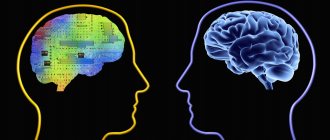KMS thinking model
Visual thinking is just one way of thinking. To explain the approach to training such thinking, let's look at one of the interpretations of the description of the thinking process. I called this interpretation the KMS model of thinking (Kishmish, Thoughts, Structure).
What happens in our heads can be divided into two main processes: unconscious and conscious. What happens in the unconscious is not always clear, but it certainly works. There are scraps of knowledge, images and much more wandering around there. In our model, let's call this part of thinking Kishmish.
The unconscious part of the CCM model. It's all Kishmish and it's scary to look there.
Already conscious thoughts appear in the conscious part, so the second part of the model is simply called Thoughts. Since we are accustomed to thinking in words, thoughts can appear in the form of thought words. And also, in the form of other various thought forms. For example, artists and architects can think in images, but for mathematicians, thought forms appear immediately in the form of mathematical formulas. So it turns out that in our heads there is a constant interaction between the unconscious and the conscious.
The unconscious and conscious parts are in the head. The interaction never stops. Thoughts are generated constantly.
But no matter what thought forms our thoughts manifest in the conscious part, there is always a problem - to keep them in the head, to build logic, to connect them into some kind of structure. To do this, you need to somehow fix them outside the head. This is where the third part of the model appears, called Structure. Working with the Structure also triggers some processes in the unconscious. And it turns out to be a kind of closed thinking process between three parts: Kishmish - Thoughts - Structure.
Triune model of thinking. Fixation in the physical world helps to catch thoughts.
Structure can be called any form of holding thoughts and building some logic for their presentation. For example, Structure can be our speech and written text. Translating thoughts into visual images and assembling them into a visual composition is also a structuring process.
The structure can be text (speech) and composition of visual objects
The definition of visual thinking can be formulated as follows.
Visual thinking is working with visual objects (images, signs), replacing work with real objects. By operating with visual images, you can structure and visually interpret your thoughts. Or visually package meanings to convey and explain them.
Within the framework of the KMS model, visual thinking is formed when thoughts are structured immediately into images (MS segment). And the difficulty of pumping it up is that for us this process is very unusual and inconvenient. Those. To directly translate thoughts into images you need to work hard. And the brain doesn’t really like to strain 
Visual thinking is when thoughts immediately turn into images
In the practice of Smyslotheka, we were faced with the question: How to improve the visual thinking of our artists? And it was the practice of answering this question that showed that it is easier to train based on the structure of the texts.
Start with "Why?"
Good visualization is always a combination of the right tools and a clearly defined goal. Therefore, in any case, you need to start with the question “What problem does my visualization solve?” The answer should be described in one or two sentences.
Additional questions could be: “what should the user learn after viewing?”, “what information is most important to convey?”
If you have decided on the goal, then you can move on to production.
Visualization through synchronization by meaning
The training process is as follows. To visualize the meaning of a text, we have to work not with the text itself, but with the field of meanings of this text. After all, different people have different concepts, contexts and meanings behind the same words. In my visual thinking trainings, I saw many times how participants visualized the same texts in different ways.
We raise the field of meaning above the text. Each word or set of words can have different meanings for different people
Having “raised” the field of meaning above the text, we work with this field and turn semantic objects into visual images. From the images, a structure is assembled - a visual composition.
For visualization, we synchronize through the field of meanings. We connect visual images in the form of a visual composition
We are more accustomed to working with text, and the training process is easier. And if we return to the KMS model, we will see that through such a training process the desired MS channel is pumped. After all, working with the field of meaning of the text, we activate the mental part of the model.
We start from the text and pump up the visual channel through thoughts
Thus, over time, the segment - MC in the KMS model is pumped up so much that you do not have difficulties with the direct translation of thoughts into images.
Of course, the question remains: “How, when training, do we move from the field of meaning to images and visual composition?”
To answer this question, we have developed and tested in practice methods, algorithms and techniques for generating a visual dictionary and assembling a visual composition. I'll tell you about them in the following notes. For those who want to immerse themselves in visualization, a distance course “Practice of Visual Thinking” has been prepared.
Or you can subscribe to the book Visual Packaging of Meanings.
At the link below you can take and apply simple techniques for assembling a visual dictionary
Learning to relax
Relaxation exercise “fists”
Sit or lie down in any comfortable position, close your eyes and begin to clench your fists.
Squeeze them harder and harder - as hard as you can. When you reach the limit of tension, stop all efforts. Your hands will relax on their own. Remember this pleasant feeling - this is the state of true relaxation. Then, in the same way, alternately create and release tension in your feet, legs, hips, shoulders, neck, and face. Then tense your whole body at once - and suddenly release the tension.
Repeat several times.
2. Relaxation exercise “inhale-exhale”
Lie down or sit in a comfortable position, close your eyes, breathe deeply, smoothly and slowly. Imagine how with each exhalation a wave passes through your body from top to bottom, carrying away all the tension, and it leaves your body through the soles of your feet.
After completely exhaling all the air from your lungs, hold your breath for a few seconds and direct your attention to your body, checking where there is still tension. Inhale and as you exhale again imagine that a relaxing wave is removing all tension from the body.
Repeat several times.
Relaxation exercise “air”
Lie down or sit in a comfortable position and close your eyes. Breathe slowly, smoothly, deeply. As you inhale, imagine that the air you inhale is entering not into your respiratory tract, but into your legs. As you exhale, imagine that the air is coming out of your legs, and with it the tension goes away.
On the next exhalation, imagine that the air enters your hands, and as you exhale, it leaves, carrying away the tension. Then, with each subsequent inhalation, alternately imagine how the air enters the stomach, chest, back, neck, head, and as you exhale it leaves, carrying away the tension.
In 3-5 minutes of this breathing you will completely relax.
4. Relaxation exercise “inflatable mattress”
This exercise is performed lying on your back. Close your eyes, breathe deeply, evenly, measuredly. Imagine that your body has become like an air mattress filled with air.
So you mentally remove the “plug” from the “mattress”, and the imaginary air begins to escape. Feel like a deflating mattress - your body becomes heavier, pressed more tightly into the surface on which you are lying, and finally turns into a deflated “rag”.
It will take you 2-3 minutes to relax.
5. Relaxation exercise “sand body”
This exercise also requires the use of imagination. Lying on your back, close your eyes, breathe deeply, slowly, evenly. Imagine that your body is a bag of sand. It is heavy and motionless. But then the sand begins to spill out through the holes in the burlap.
It slowly flows out in thin streams. Heaviness and tension go away along with it. The body becomes light and seemingly shapeless. You may even stop feeling the boundaries of your body, as if “dissolving” in the surrounding space.
If you do this exercise before bed, it will help you fall asleep. But if you have to get up and return to normal activities, then, after relaxing and resting well, then clench and unclench your fists several times and stretch to regain awareness of your body.
Relaxation exercises not only make it easier to reach the alpha level, but are healing in themselves, significantly reducing stress levels and helping to quickly relax and restore strength.
I liked the article, subscribe to the most interesting and useful materials on the topic >>>
Dear visitor! I am constantly developing my abilities, experimenting with various techniques and practices. If you want to know about these experiments, subscribe to the blog news. I share confidential information only with subscribers.
FIRST TIME ON THE BLOG? FIND THE INFORMATION YOU ARE INTERESTED BY THIS LINK >>>
I recommend:
Charity course “BE YOURSELF A HEALER” >>>
Go through a number of effective techniques and practices to help improve your destiny and achieve your goals >>>
Develop your abilities through the opening of energy centers. Download the book “The Standard State of the Chakras”, which will help you reach a new vibrational level.
Learn to control your destiny, make your dreams come true and achieve your goals in 30 days.
Basic Principles of the Law of Attraction
The main principles of the law of attraction and the fulfillment of desires are the fundamental principles on which this law is based. To make your wish come true, you should:
- formulate it clearly and precisely;
- imagine what positive feelings and emotions you would experience if you already had everything you dream of;
- enter into the emotional state that would arise if your desire had already come true;
- try to stay in this state for as long as possible every day.
By experiencing pleasure from positive feelings and emotions, you give a signal to the Universe, which begins to create all the necessary conditions for making your desire come true!
Don’t think that positive thoughts alone can radically change your life. You need to feel and feel every thought, become close to it, charge it with positive emotions and, as it were, live it.
We place accents
I would like to mention a simple but important tool for focusing the reader’s attention - the pop-up effect.
Pop-up is the deliberate highlighting of some part of the visualization so that it immediately catches the user’s eye. For example, imagine that we want to quickly convey to the reader of our sports newspaper what results our athletes showed at the Olympics in comparison with other countries. Let's take a basic, ascending-sorted list of countries with medals.
I think it's worth turning it over.
Yes, this is definitely better, and Ukraine is, in principle, quite distinguishable, but if we add a little emphasis, it will be even clearer.
Personally, for my taste, I would also make a pop-up not by changing the color, but by adding saturation - this way the diagram will be more concise and aesthetically pleasing.
The pop-up effect allows the visual system to process information in parallel and quickly find the main thing - this is its main advantage.
This effect can be achieved well with:
- colors,
- orientation,
- size,
- shapes,
- proximity.
But for example, channels such as tilt angle or parallelism will not allow you to make a pop-up. The more capacious the visual channel itself, the more powerful the pop-up we can make. Most pairs of visual channels cannot create this effect, and the color + position pair will be the leader in understandability.
Try, for example, to find a red circle here. Visualization of the “shape + color” format becomes a rebus, not an assistant.
How to visualize a goal correctly?
To ensure the process is correct, the following points should be taken into account:
- Commensurability and clarity of the goal, the visualization of which is so necessary. You should use: “I need 10 thousand for the trip,” and the expression “I want to have a lot of money” will not work.
- Be able to adapt. Thinking about future events creates anxiety and fear. You should imagine the worst-case scenarios that might occur and think of strategies to overcome them. And the panic feelings will pass.
- Note down the thought on a piece of paper or in an audio file. By reading or listening repeatedly, words are encoded by the brain, which contributes to better perception by different senses.
- Detailing. The little things are very important here.
- Recording a desire within a time frame. You need to write down about six specific, challenging but achievable intentions. The time frame will make them realistically feasible in the near future.
- Mental representation of the result. Visualizing a positive thought stimulates the achievement of desires. Everything should be written down in detail. How do you feel at a particular moment? Your thoughts?
- Internal barriers. Constraints should also be described. But not those that a person is unable to control. It’s better to plan everything in advance, calculate every response step to your internal barrier.
Achieving a goal through visualization is quite real and affects our lives in a positive way.
conclusions
Let's summarize.
- Visualization is a symbolic language for representing data in a visual form.
- The topic of data visualization is now so popular, since graphs and diagrams allow you to save time and mental effort when studying a large amount of information.
- Proper visualization helps to observe the data as a whole and prevents a person from being too inclined to divide everything into “left” and “right”, this improves the quality of decisions made.
- Visualization skills will become increasingly relevant (as the amount of information grows), and therefore, for any digital specialist, basic literacy in this matter is required.
- You should start your visualization with the question “Why is it needed?”, “What task does this infographic simplify?” After this, it will become clear what data needs to be collected and what is the priority to display.
- To build a visualization, you need to go through three steps: count the number of variables, determine the data type of each variable and, finally, select the visual channels to display.
- Not all visual channels are perceived equally well by humans. Therefore, it is worth remembering the priorities of attention and encoding important data using the strongest channels.
- Do not forget that the channels must be capacious enough to display the full diversity of the sample, and at the same time independent to the required extent so as not to spoil the reader’s impression.
- Place accents - the visual system processes the right pop-up in parallel, and this makes visualization even more effective.
- To build non-standard and irregular infographics, you can use specialized online services.
- To regularly work with data dynamics, such as management reports, use tools like Google Data Studio, as well as built-in reports from advertising platforms or more complex systems like Power BI.
Thank you very much to everyone who read this article to the end, I hope that the information was useful and interesting for you! Several more articles can be written about visualization, so if you are interested in learning additional nuances, write in the comments.
I wish everyone successful advertising campaigns and clear visualizations!










